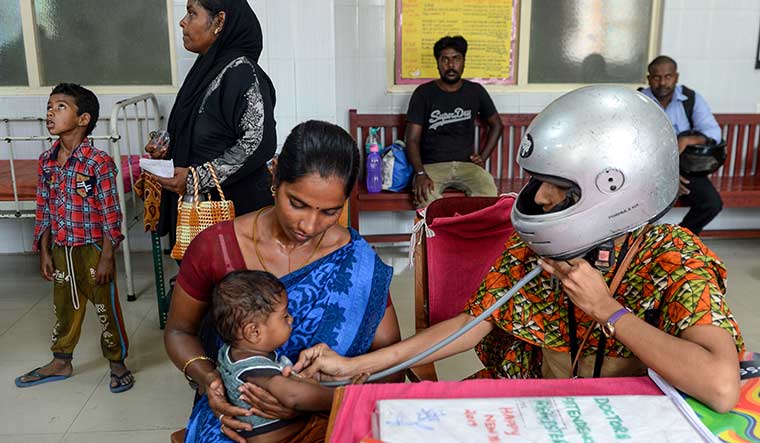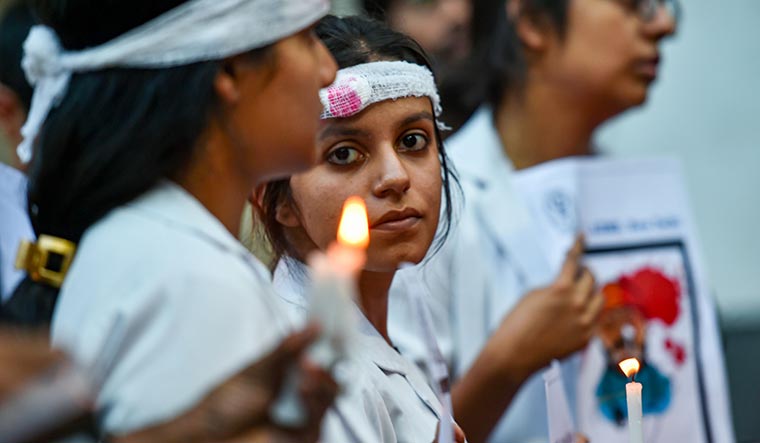For Dr Neha Verma, 28, strikes have been part of her training as a medical professional. As a first-year student of medicine, Verma, now a resident at Delhi’s Kasturba Hospital, has seen her fraternity at loggerheads with the administration of government hospitals, typically over the issue of violence by patients and their attendants. “Verbal abuse and physical aggression against doctors is not new; neither is the agitation against it. We have learnt to live in fear. I carry a pepper spray and a small knife in my bag, especially when I am working on an emergency case,” says Verma, who requested that her real name not be used in the story.
On June 17, doctors in West Bengal and across the country called off their agitation to demand a safe workplace and strict punishment against those who assault doctors after they received assurances from both the Central and the state governments. The Indian Medical Association, an influential body of doctors that boasts a membership of 3.5 lakh doctors, said that though the strike had been called off, the struggle would continue “for a comprehensive, Central law” that serves as a deterrent against such violence, provides for adequate security for doctors and addresses the root cause of such incidents of violence. Such a law would not only prohibit violence, but also allow for compensation to the hospital and penalty for “improper investigations”. To that end, the IMA would conduct “workshops, work with political parties, doctor MPs, professional associations and NGOs” to create awareness and ensure that such a law was passed by Parliament.
Also, Union Health Minister Dr Harsh Vardhan wrote to the chief ministers to consider enacting a specific legislation for protecting doctors and medical professionals, and sent them a copy of the draft law—The Protection of Medical Service Persons and Medical Service Institutions (Prevention of Violence and Damage or Loss of Property) Act, 2017. He also asked them to enforce the provisions of the Indian Penal Code, the Criminal Procedure Code with vigour in states where such a law was not present and take strict action in case of assault against a doctor.
“The current draft [of the law] deals only with the punishment part of it, where the person who assaults a doctor can be punished with seven years of imprisonment, and the offence is a non-bailable one,” says Kerala-based Dr R.V. Asokan, honorary secretary of the IMA. “We are pushing for a Central law that deals not just with that, but also ensures that hospitals have a three-layer security system with CCTVs and restricted entry of visitors.”
Also, the IMA wants the law to address the shortage of doctors, which is the root cause of the problem. “Each year, of the 68,000 [MBBS graduates], only 28,000 go for postgraduation. The [rest] 40,000 need jobs, but the government is not filling up vacancies for permanent jobs. The young MBBS doctor is jobless, frustrated and angry,” says Asokan.
However, Verma, one of the several resident doctors across the country who, as frontline health care workers, are more vulnerable to such violence, is unsure whether such a law would change things on the ground. She concedes that the need for adequate security in hospitals is high, but says that the issue of doctor-patient mistrust and the ensuing violence is systemic. For instance, at her hospital—one of Asia's largest maternity hospitals—on an average, the maternity ward has 60-70 patients, that too on a “lean” day, and only two residents to attend to all of them. “I have been on duty since 9am yesterday, and though my shift ended at 9am today, I won’t leave until 1pm. In my 24-hour shifts, I don't know when I will eat or rest because of the heavy patient load,” she says. “Besides, if I am doing this every third day, how does the government expect me to be able to attend to all the patients properly and be compassionate towards everyone? I am bound to make mistakes and invite the wrath of the patients' families.”
Verma, who is in her third year of postgraduation in gynaecology, says while doctors are ready to brave it all, they are handicapped when there is a lack of supplies and basic infrastructure. “At my hospital, we don’t even have basic medicines such as oxytocin and misoprostol, which are mandatory in a delivery ward,” she says. “If we ask patients to bring these things from outside, they get upset and ask us, ‘Why don’t you get it yourself?’ Yesterday, I didn’t even have sutures to do the stitches, and the blood bank was out of all negative blood groups. Patients don’t, and won't, understand our situation. They blame us for the pitiful conditions.”
In Kolkata, which was the epicentre of the recent doctors' protests after two junior doctors were attacked by a patient's kin at the NRS Medical College and Hospital, Dr Vijay Mukherjee (name changed on request), 40, an emergency physician at a private multi-speciality hospital, says that though doctors across government and private hospitals were at the receiving end of violence from patient attendants, those manning the emergency wards at government hospitals were especially vulnerable. “These wards are often manned by interns or junior medical officers who are overworked and not trained properly to handle such situations. Besides, the infrastructure at government hospitals is crumbling, even basic supplies such as ventilators are not available at several government hospitals in the state,” says Mukherjee, who is part of the West Bengal Doctors' Forum that has 1,500 paid members and a membership of 18,000 on social media.
In West Bengal, the face-off between the government and doctors escalated largely due to Chief Minister Mamata Banerjee's “high-handed” attitude, new laws such as the Clinical Establishment Act that doctors in the state say has branded them as “thieves out to fleece patients” and the rising incidents of violence, says Mukherjee. The situation, however, is the same across the country, he adds.
“In the last two years, doctors' bodies in the state have registered 240 cases of violence. However, in none of these cases, the police has taken any action,” says Mukherjee. “The fact that we have The West Bengal Medicare Service Persons and Medicare Service Institutions (Prevention of Violence and Damage to Property) Act, 2009, has not changed our situation because of lack of awareness on the subject, especially where police officers are concerned,” he says. At least 19 other states, like Delhi, Assam, Andhra Pradesh, Goa and Chhattisgarh, have enacted similar laws, but doctors, many of whom are unaware of such legislation, insist their plight has not changed.
The need for a Central law, says Asokan, has risen because despite the existing laws, there has not been a single conviction in cases of violence. “If the government can have a law such as POCSO [Protection of Children from Sexual Offences], with stringent provisions to deal with the crime of child abuse, why not have one to address violence against us?” asks Asokan, adding that the specifics of such a law were still being worked out.
Both Mukherjee and Verma say that more laws would not improve the situation of their lot. “Unless the government puts money in its hospitals, creates better infrastructure, improves the supply of medicines, and gets more doctors on its rolls, we will not be safe, and will continue to be at the receiving end of the public anger,” says Verma. “Young doctors such as me will not want to work in this country, certainly not in its government hospitals, and will move out of the country.” The point, says Mukherjee, is not having a new law, but its implementation. “With a new scheme such as Ayushman Bharat, the demand will rise, but where are the facilities?” he asks. “We also need to have uniform treatment protocols across the country so that doctors are not blamed in case of a casualty.”
A young resident doctor at a government medical college in Haldwani, Uttarakhand, draws an apt analogy: “The government only wants people to put on helmets. But it won't consider improving the state of the country's roads or enforce traffic rules. In such a situation, accidents are bound to happen.”




